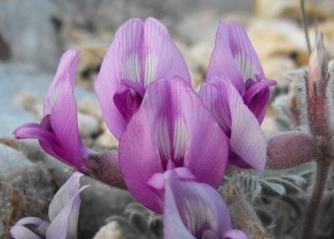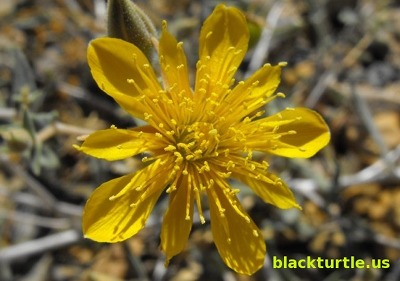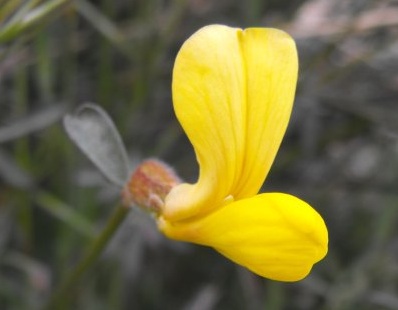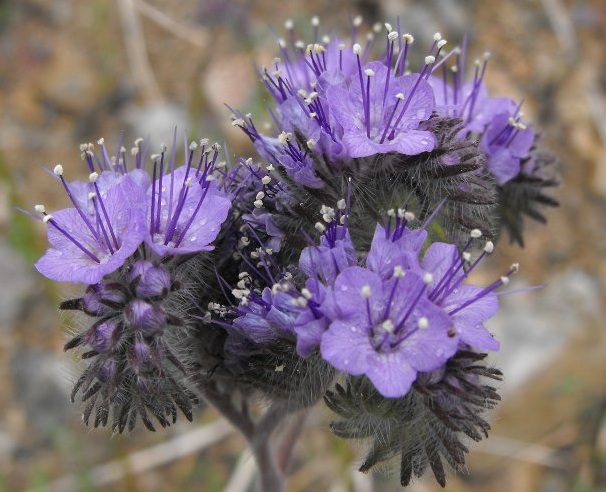|
|

|
Milkvetch
January/February
There are several species of milkvetch which grow in and around Death
Valley. The one shown here was found growing at Panamint Valley Dunes and is
known by the scientific name Astragalus lentiginosus, eleven varieties of
which are found in California. The specimen shown here is almost certainly
an example of the variety called variabilis. According to DeDecker it is
found from the Panamint Dunes and southward, growing at elevations between
2200-3400 feet. Incidentally, an extract of the root of Astragalus
membranaceus, called TA-65, is believed to have anti-viral and anti-aging
effects.
(Click here for more info!)
|

|
Rosy Apricot Mallow
March/April
Apricot Mallow, or Desert Mallow, is highly variable in terms of size, leaf
shape, and flower color. There are three varieties of this species
(Sphaeralcea ambigua) which grow in the Death Valley area listed by
DeDecker: ambigua, monticola, and rosacea. BTW, other plants that are
members of the Mallow Family include hollyhock, hibiscus, cotton, and okra!
LINKS:
(Rosy Apricot Mallow Info!)
(Desert Mallow Info!)
|

|
Argus Blazing Star
May/June
Seeing as this plant is found in the mountainous areas of Inyo County, it
isn't surprising that it is also known as Inyo Blazing Star. In fact, many
plant books list it as such. However, Argus Blazing Star (Mentzelia
oreophila) is also an appropriate name, especially since there is another
species (Mentzelia inyoensis) that has Inyo Blazing Star as it's common
name. Of course, Argus Blazing Star doesn't just grow in the Argus Range, or
in Inyo County for that matter. It can be found throughout much of the
desert southwest, growing at altitudes between 1800 and 6000 feet.
(Click here for more info!)
|

|
Flax
July/August
Although common flax (Linum usitatissimum) is not native to North America,
it does occasionally grow wild on this continent. It is also closely related
to western blue flax (Linum lewisii), which may be found in the Death Valley
area growing above 7500 feet in the Inyo, White, and Panamint ranges.
Interestingly, L. lewisii is the only member of the Flax Family listed by
DeDecker that is found in the northern Mojave region. The seeds of common
flax are a great source of essential fatty acids and fiber!
(Click here for more info!)
|

|
Rock Pea
September/October
Although most desert wildflower books assert that Rock Pea blooms from March
to May, I have often found some fresh flowers on these plants during
January. This last week I encountered some Rock Pea flowers at an elevation
of about 4000 feet while hiking in the Argus Range near Rattlenake Springs.
Formerly classified as Lotus rigidus, this plant is now officially known as
Acmispon rigidus. Another common name for this plant is deervetch, BTW.
(Click here for more info!)
|

|
Notchleaf Phacelia
November/December
Although poison oak does not grow in the Death Valley area, there is another
plant that is fairly prevalent in the area that can cause dermatitis, at
least in some people. For this reason it is best to avoid physical contact
with Notchleaf Phacelia. One of the more descriptive alternate common names
for this plant is scorpionweed, which is especially appropriate since the
small flowers form in clusters that are coiled in a manner that is
reminiscent of the tail of a scorpion. Formerly this plant was a member of
the Waterleaf Family (Hydrophyllaceae), but it has been reclassified and is
now a member of the Borage Family (Boraginaceae).
(Click here for more info!)
|
|
| |
|

blackturtle.us
PLANT
BLOG
BLOG INDEX
ASSOCIATED SITES:
Trona News
Rusky Ed
Any Place Education








|

















